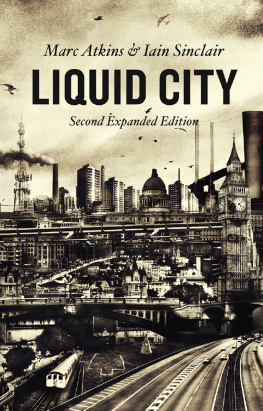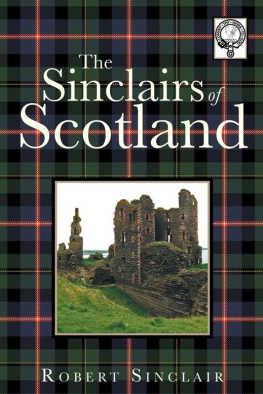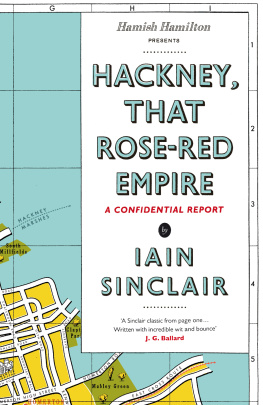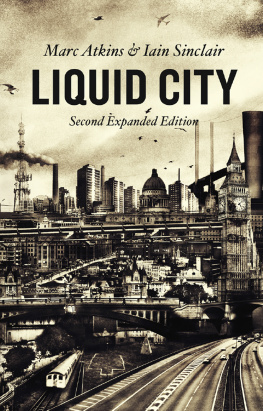[In Liquid City] Atkins penetrating black and white portraits and his beautiful, troubling shots of a London we forget we know dominate. Sinclair adds occasional pieces in a lighter, more journalistic prose than readers of his wonderful, overwrought novels might expect, discussing Atkins, or one of his photographs, and their mutual project of attempting to pin down the story that is London This attempt to articulate a truth about a space is an impossible project, and it is impossible to hold a fixed position on it as the title Liquid City suggests This is a visual feast of contemporary photojournalism, in which Atkins visions and Sinclairs words help the reader perceive a London that can easily be walked past daily.
Mark Thwaite, Amazon.co.uk
The London landscape that Atkins and Sinclair conjure up is a haunted one, and I suspect their imagery will continue to haunt readers long after they close this book. I have no doubt that this will become accepted as one of the most essential texts for anyone who cares for London.
Joe Kerr, Blueprint Magazine
Sinclair unravels mystical and historical threads from glimpses of the citys landscape: spires, secret courtyards, hidden gravestones. The city itself is a narrative the London [Sinclair] and Atkins present is like a parallel city, an alternate world that exists only through the alchemy of Atkins grainy prints and Sinclairs incandescent prose.
Stephanie Merritt, The Observer Review
I still think Atkins is our real discovery. There are bits of his photos that scare me. He sees things that I have never considered pieces of undisturbed debris and scatterings of lost thoughts that echo from windows high above. I shiver a bit. My mind takes hold of memories of people I have never seen, strangers, in the future as well as the past.
Annie Morrand, Rising East
Marc Atkins is a dark-edged photographer of Londons hidden places secret histories and sinister characters. Noirish, morbid and dramatizing, Atkins photography captures an urban state of mind.
Jonathan Jones, The Guardian
stunning photographs Atkinss use of eye, paper and chemicals is an alchemical homage to the mystery of light and dark.
Jah Wobble, Independent on Sunday
Liquid City is Alice in Wonderland for urban intellectuals, a book that just gets curiouser and curiouser. Which is what makes it so particular, of course, and so utterly alluring.
Melanie McGrath, London Evening Standard
Sinclairs writing is pitched somewhere between prose and poetry, a kind of staccato jazz with a literariness.
Chris Hall, Building Design
Liquid City offers images of terrible, desperate beauty and the poetic, enjoyably jerky text ventures far below the picturesque surface and outside the magnetic pull of central London.
Andrew Barrow, The Spectator
haunting are his odd images reminiscent of Man Rays, of the human figure photographed in the intimacy of a curtained room. Atkins has worked the light over and over in the darkroom, burning away layers of detail, drawing down a veil that suggests roughed-up archive celluloid, transforming a person into an apparition.
- Tristan Quinn, New Statesman
entertaining and thought-provoking
RIBA Journal
atmospheric photographs extraordinarily visual language [a] fascinating record.
Stephen Gardiner, London Magazine
Atkins vision of London is crepuscular, even when its broad daylight. Theres always a sense that what you cant see is made visible in other forms. The creatures of the night have a transparency that nonetheless casts a shadow. Time past is contained in time future, and time future is contained in time past, as Eliot put it. Marc Atkins images are evidence that the poetic thought can infect even the most perfectly scientific of discourses.
HotShoe International Magazine
LIQUID CITY
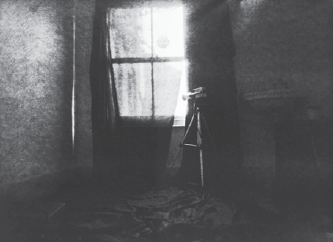

Marc Atkins and Iain Sinclair
Liquid City
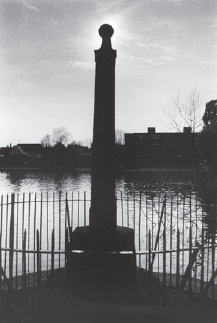
SECOND EXPANDED EDITION
REAKTION BOOKS
Published by Reaktion Books Ltd
Unit 32, Waterside
4448 Wharf Road
London N1 7UX, UK
WWW.REAKTIONBOOKS.CO.UK
First published 1999
Second expanded edition published 2016
Photographs copyright 1999, 2016 Marc Atkins
Text copyright 1999 Iain Sinclair
Hard water, soft stone 2016 Iain Sinclair
All rights reserved
No part of this publication may be reproduced, stored in a retrieval system, or transmitted, in any form or by any means, electronic, mechanical, photocopying, recording or otherwise, without the prior permission of the publishers
Printed and bound in Great Britain by TJ International, Padstow, Cornwall
A catalogue record for this book is available from the British Library
eISBN: 9781780236179
ACKNOWLEDGEMENTS
Earlier versions of some of these pieces appeared in the following publications: A Serious of Photographs in The Ebbing of the Kraft (Equipage, 1997); Is This London? in Alive in Parts of This Century: Eric Mottram at 70 (North & South, 1994); Sion Ants in Subversion in the Street of Shame (Disobey, 1994); Watching the Watchman (Jago Gallery, 1997); Hungry Ghost in Back Garden Poems (Albion Village Press, 1970); Where the Talent Is (Penguin Modern Poets 10, 1996); Kathy Acker & The Falconer (World Art, 1998); Whitechapel / New York (Winter New York, 1994). Iain Sinclair would like to thank these editors: Rod Mengham, Peterjon & Yasmin Skelt, Paul Smith, Keggie Carew, Ashley Crawford and Anet van de Elzen.
Marc Atkins wishes to thank Franoise Lacroix, Michelle Lacroix, Natasha Lythgoe and Lil. The images on pages are from Atkinss video Through the Corner of an Eye (1998).
I followed him; who, shadowlike and frail, Unswervingly though slowly onward went.
Regardless, wrapt in thought as in a veil: Thus step for step with lonely sounding feet We travelled many a long dim silent street.
JAMES THOMSON, The City of Dreadful Night
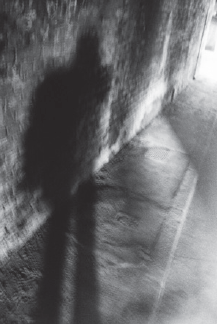
Hard water, soft stone
Liquid City. The title came from Marc Atkins. He references the Thames as Londons bloodline; a dangerous, sediment-clogged artery under shifting, monumental skies. There is a quite distinct nod at the old Conradian pitch, coming upstream from Tilbury, witnessing sullen ghosts of industry, and catching glints of rising or dying sun on the towers of white churches and embryo investment silos. That romance is serviced, but the city of the essayist-photographer is now deserted, even by the robotic dead who once shuffled over London Bridge to their desks in King William Street. The rivers tent is definitively broken, but the lifeless hump of the Millennium Dome is yet to be fully inflated. We are caught between times, rimming still mysterious edgelands, prospecting for narrative. Is this London? asks a bemused Frenchman, when our paths cross on the wrong side of the river, on the nursery slopes of Shooters Hill.
The audience is invited to step under the black hood. They are transported to a smoking Victorian slideshow. Image bleeds into image in a panorama of monochrome blight. Captured authors and artists are frozen like Cesare Lombrosos generic malefactors. Significant stones and cracked monuments are assembled in a virtuoso display that should have been the first exhibition in New Labours flabby marquee on Bugsbys Marshes: real content, a secret history, in place of vacuous self-promotion. As Chris Petit put it, talking about Berlin in 1943, all the energies of the moment seem to lurch between paranoia and inertia.

